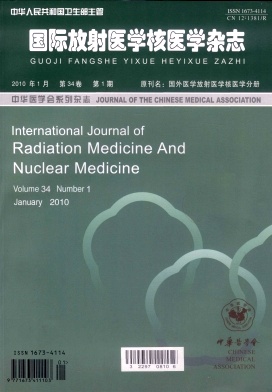-
血管生成是从原有血管芽生出新生毛细血管的过程, 其中生理性血管生成在维持正常的脉管系统、女性生殖周期及促进创伤愈合方面起着重要的作用, 而病理性血管生成则与糖尿病视网膜病变、关节炎、子宫内膜异位症、恶性肿瘤生长及转移等密切相关[1]。研究证实, 肿瘤大于2 mm时, 主要通过新生血管输送足够的养分和排除代谢废物, 并为其转移提供便利[2]; 血管生成需多种因子的参与, 其中血管内皮生长因子(vascular endothelial growth factor, VEGF)信号通路是主要的限速环节[3]; VEGF受体(VEGF receptor, VEGFR)在肿瘤血管内皮细胞及多种肿瘤细胞膜上呈高水平表达, 是具有潜在应用价值的靶分子, 并已成为靶向抗肿瘤血管生成治疗的研究热点。受体显像是集配体-受体结合的高特异性和放射性核素探测的高敏感性于一体的分子影像诊断技术, 能够准确显示体内受体的空间分布、密度与亲和力, 在临床肿瘤诊疗中已展示出广阔的应用前景。本文就VEGF、VEGFR、VEGFR与肿瘤及肿瘤VEGFR显像研究现状进行简要综述。
HTML
-
VEGF是一组由VEGF-A、VEGF-F及胎盘生长因子组成的家族, 其中VEGF-A具有激活VEGFR-1和VEGFR-2的功能, 在血管生成中起主要作用, 通常所指的VEGF即为VEGF-A。编码人VEGF-A基因的染色体定位于6p21.3, 由8个外显子和7个内含子组成, 不同的外显子拼接方式产生4种不同的亚型, 分别为VEGF121、VEGF165、VEGF189与VEGF206。其中VEGF165是最重要的一个亚型, 它缺少第6外显子编码的氨基酸残基, 属于具有肝素结合活性的糖蛋白, 分子质量为45×103。
VEGF的作用包括: ①促进血管内皮细胞分裂生长、出芽并侵入胶原, 进而促进血管生成, 并维持内皮细胞的生存; ②促进骨髓单核细胞的趋化, 诱导集落形成; ③抑制成年鼠树突状细胞的发生。在缺乏血管系统的果蝇体内, VEGF的转导通路在造血过程中发挥重要作用, 控制着血细胞的迁移和增殖[4]。
VEGF基因的表达受氧浓度、多种生长因子、激素及癌基因等的调控, VEGF mRNA的表达在多种病理环境中由低氧诱导[5]。表皮生长因子、肿瘤生长因子、角质化细胞生长因子、血小板源性生长因子、促甲状腺激素、促肾上腺皮质激素、促性腺激素、绒毛膜促性腺激素、癌基因的突变和扩增等均可上调VEGF mRNA的表达。
-
目前的研究结果表明, VEGFR主要有5种亚型: ①VEGFR-1, 即fms样酪氨酸激酶1(fms-like tyrosine kinase-1, Flt-1);②VEGFR-2, 即含激酶插入域的受体/胎肝激酶(kinase insert domain receptor fetal liver kinase-1, KDR/Flk-1), 在人类称为KDR, 在鼠类称为Flk-1;③VEGFR-3(Flt-4);④神经毡蛋白1(neuropilin-1, NP-1);⑤NP-2。其中, VEGFR-1与VEGFR-2是最重要的两个亚型, 两者均由含7个免疫球蛋白样结构域的胞外区、单个跨膜区及含激酶插入结构域的酪氨酸激酶序列胞内区组成。
在胚胎发育过程中, VEGFR-1的缺失会引起成血管细胞的过度增殖, 最终导致胚胎的死亡[6], 提示VEGFR-1在此过程中有着至关重要的血管生成负性调节作用。然而, 在VEGF高表达的肿瘤、炎症、动脉粥样硬化等病理条件下, VEGFR-1却发挥正性调节作用[7]。这些研究表明, VEGFR-1在血管生成过程中起双重作用。此外, VEGFR-1通过与VEGF或胎盘生长因子的结合可启动下游信号转导, 促进骨髓单核细胞的迁移、造血及内皮祖细胞的募集[8]。尽管VEGFR-1与VEGF结合的亲和力非常高(Kd=2~10 pmol/L), 比VEGFR-2至少高一个数量级, 但其酪氨酸激酶活性却相对较低[9], 表明VEGFR-2是促进血管生成的主要受体。研究证实, VEGFR-2对内皮细胞前体细胞分化成为内皮细胞及内皮细胞的增殖是必需的[10]。在大多数肿瘤的血管生成和糖尿病视网膜病变的动物模型中, VEGFR-2发挥主要作用, 而VEGFR-1只在某些肿瘤血管生成和风湿病及动脉粥样硬化中起重要作用[11]。
综上所述, 在胚胎生成早期, VEGFR-1与VEGFR-2的作用相反, 以保持血管生成的平衡; 出生后, VEGFR-1主要在炎症及造血过程中起作用, 而VEGFR-2则成为血管生成的主要受体。
-
在正常组织和良性肿瘤中, VEGFR低表达或不表达; 但在多种恶性肿瘤如子宫内膜癌、卵巢肿瘤、乳腺癌、胰岛细胞癌等组织中的VEGFR-2呈高水平表达, 不仅肿瘤组织中血管内皮细胞有VEGFR-2表达, 而且某些肿瘤细胞本身也有VEGFR-2表达。VEGF及VEGFR-2表达有随肿瘤恶性程度增加而递增的趋势, 如人结肠癌, 而肺鳞癌染色较弱[13]。肿瘤组织内血管内皮细胞及某些肿瘤细胞的高水平表达VEGFR-2, 已成为人们关注的、具有潜在应用价值的靶分子, 奠定了针对VEGFR-2的肿瘤诊断与靶向抗肿瘤血管生成治疗研究的理论基础。
-
VEGFR显像可探测恶性实体肿瘤的原发、转移与复发灶, 根据显像剂的浓聚程度判断受体的表达数量, 通过放、化疗前后对比可客观评价疗效, 并对临床实施针对VEGFR的肿瘤个体化生物治疗具有积极的指导作用。依据显像剂所用的放射性核素的不同, 肿瘤VEGFR显像分为SPECT和PET两类。
-
目前, 用于VEGFR的SPECT研究较多的显像剂是123I-VEGF165和123I-VEGF121。Li等[14]研究显示, 123I-VEGF165和123I-VEGF121不仅与人脐静脉内皮细胞结合, 而且与肿瘤细胞特异性结合。在胰腺癌及结肠癌中, 虽然123I-VEGF165和123I-VEGF121可以浓聚于原发及转移病灶中, 但在甲状腺与胃中的浓聚更高, 而且T/NT值也不高, 这是由于该类显像剂在体内不稳定, 易脱碘而致。并且, 123I-VEGF121的浓聚随肿瘤体积的增加而减弱, 表明肿瘤VEGFR的表达随肿瘤体积的增加而减少[15-16]。除了放射性碘, VEGF121还可以用99Tcm进行标记。在鼠4T1乳腺癌模型中, 99Tcm-VEGF121在体内可稳定存在1 h, 肿瘤组织对99Tcm-VEGF121的摄取值为3% ID/g, 且通过对肿瘤化疗前后的显像可用于疗效的判断[17]。
除了对VEGF本身进行标记, 还可从基因水平改进VEGF及其受体的结构后进行标记, 从而得到更好的显像效果。Qin等[18]应用188Re标记VEGF189外显子6编码的十二肽, 通过将VEGFR-2基因截断后转染至肿瘤细胞, 使标记物与VEGFR的亲和力增强, 进而使T/NT值由2.53±0.33增加至3.61±0.59。
此外, 也可以将含VEGF的融合蛋白作为VEGFR显像剂。人转铁蛋白-VEGF是VEGF165与人转铁蛋白的融合蛋白, 将其进行111In标记后注射入荷瘤裸鼠体内, 注射后72 h, U87MG人胶质瘤细胞的摄取值为6.7%ID/g, 而大量非标记VEGF抑制后, 摄取值明显降低。这一融合蛋白的显著优点在于标记时不需引入螯合剂[19]。单链VEGF也是一种融合蛋白, 用99Tcm标记后, 可显著浓聚于肿瘤病灶, 而失活后的单链VEGF标记后则未出现明显的显像剂浓聚[20]。
以上都是以VEGF或VEGF衍生物作为显像剂, VEGFR小分子拮抗剂也可与VEGFR-2特异性结合, 能够抑制VEGFR的酪氨酸激酶活性。这一类小分子拮抗剂很多, 且发展十分迅速, 有望成为治疗实体肿瘤的新药物[21], 但针对该类化合物的VEGFR显像研究并不多。
近年来, 噬菌体展示技术及核糖体展示技术的出现为寻找VEGFR特异性结合物提供了一个新的途径。Hetian等[22]应用噬菌体展示技术筛选得到了VEGFR-2的拮抗小肽K237, 经实验证实可以抑制肿瘤的生长和转移。对该肽进行99Tcm标记, 也不失为探索VEGFR显像的良好途径。
-
PET是目前核医学最先进的影像技术, 对此, 放射性核素标记抗VEGF单抗的应用较多。124I标记的抗VEGF单抗HuMV833PET可用于检测肿瘤患者体内HuMV833的分布和清除情况[23]。89Zr标记的bevacizumab在肿瘤中的摄取虽比89Zr-免疫球蛋白G高, 但较111In-bevacizumab低, 表明其疗效的局限性[24]。利用1, 4, 7, 10-四氮杂环十二烷-N, N', N', N''-四乙酸(1, 4, 7, 10-tetraazacyclododecane-N, N', N', N''-tetraacetic acid, DOTA)形成的64Cu-DOTAVEGF121在小动物U87MG肿瘤模型PET中, 可迅速特异地被摄取入肿瘤组织, 并且摄取值可达15% ID/g, 而在肿瘤较大时, 摄取值降至3%ID/g, 这表明肿瘤在演进过程中, VEGFR的表达逐渐减少, 针对该受体的生物治疗效果也变差。因此, 通过VEGFR表达无创性PET, 可为临床确定是否行针对该受体的治疗及治疗时机提供依据[25]。但该标记物在肾脏中浓聚较多, 存在较强的肾毒性, 而据报道, 已有一种64Cu-DOTA-VEGF类似物具有与64Cu-DOTA-VEGF121相似的肿瘤显像效果, 但肾毒性明显降低[26]。








 DownLoad:
DownLoad: